Best Performance Management Software
Performance management software is a collection of tools that facilitate HR management by analyzing employees' performance effectively. The software assists employers in arranging training courses for underperforming employees while preparing to reward the best performers.
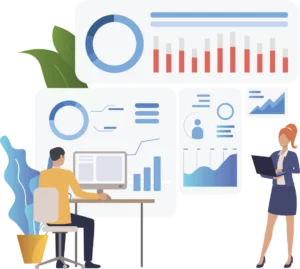
Performance Management Software
What Is Performance Management Software?
Performance management software is a set of tools that consistently tracks employee performance at certain intervals, measures it using a performance matrix, further analyses it, and delivers feedback.
It is a combination of technology and methods where employers measure employees’ contributions based on their performance metrics and decide whether they deserve recognition or need extra support or training.
According to verified market research, the market size of performance management software will surpass USD 3.21 billion in 2024 and reach around USD 7.47 billion by 2031, at a CAGR of 12.29% from 2024 to 2031.
11 Best Performance Management Software
Following are eleven of the best performance management software in India currently. We’ve also put together a useful list of the best payroll software in India. This list provides information on the features and pricing of each software. You can find all this information in our article.

Pocket HRMS is a comprehensive AI-based cloud HRMS solution for all sizes of businesses from SMEs to enterprises. It has an in-depth performance management system and advanced analytics and reporting module, as well as integrated rewards and recognition options, making it India’s best performance management software.
▸Key Features:
Enhanced customizable performance management
In-depth analytics & reporting
Comprehensive rewards & recognition system
▸Pricing:
Standard Plan: ₹60 per employee per month.
Professional Plan: ₹ 90 per employee per month.
Premium Plan: Quote on demand
2. DarwinBox
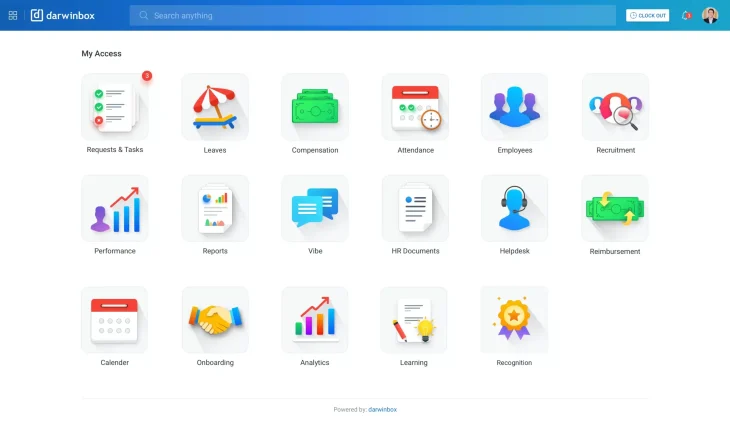
DarwinBox includes multiple modules which are relevant for performance management in a company. Since it is a comprehensive suite of HRMS modules, its talent management module is highly customizable, enabling companies to tweak it to their exact specifications.
▸Key Features:
A comprehensive suite of various HRMS Modules
Highly customizable talent management module
Slightly complex for a 1-man HR department
▸Pricing:
Quote on Demand
3. HRSoft
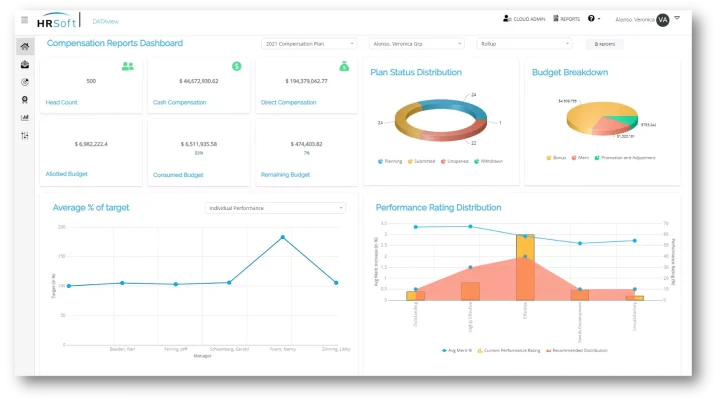
HRSoft is another extremely capable HRMS, which provides advanced performance management features. It has a flexible performance management module, which can also be integrated with other business solutions for a streamlined experience.
▸Key Features:
Integrated performance management
Improved compensation management
In-depth rewards and recognition
▸Pricing:
Quote on demand
4. GreytHR
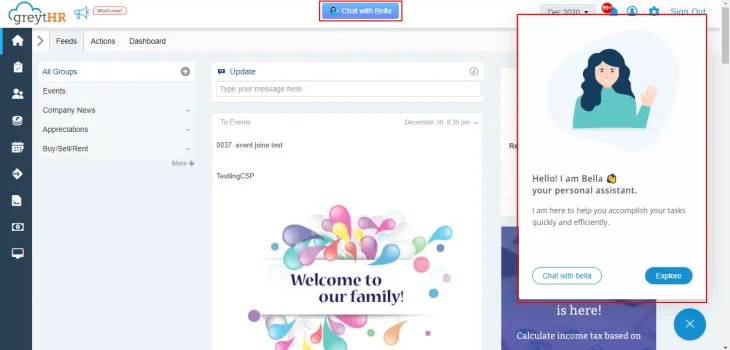
GreytHR’s performance management module provides various options for managing employee performance goals. Being a complete HR management software, it provides payroll management, performance tracking, rewards and recognition, and others.
▸Key Features:
Integrated performance management with payroll management
Comprehensive HR suite
▸Pricing:
Essential Plan: ₹3495/month for up to 50 employees
Growth Plan: ₹5495/month for up to 50 employees
Enterprise Plan: ₹7495/month for up to 50 employees
5. ZingHR
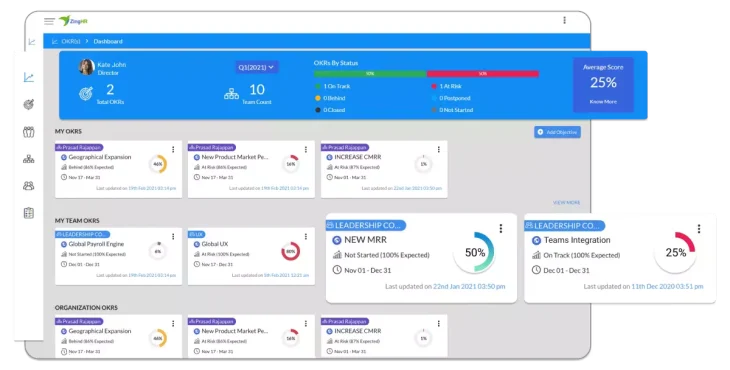
ZingHR is another popular performance management and HR software which provides multiple features which help track and manage employees’ performance effectively. It provides several performance management-related options such as goal-setting, feedback mechanisms, performance tracking, and more.
▸Key Features:
Simplified interface with multiple customization options
Easy reporting and analytics options
▸Pricing:
Quote on demand
6. Trakstar
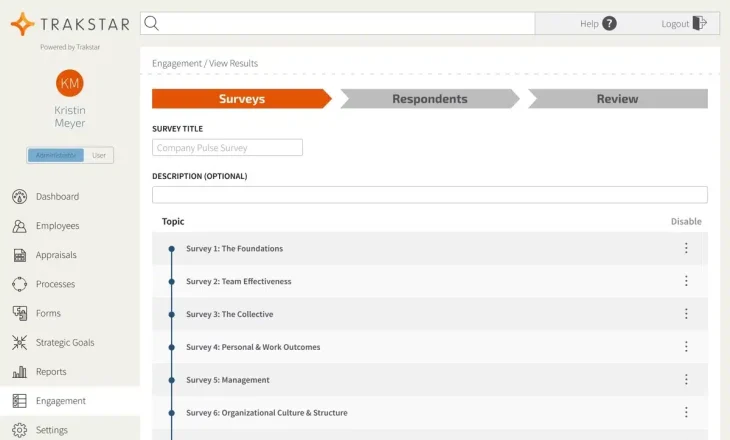
Trakstar is one of the top performance management software for enterprises since it primarily focuses on tracking employees’ performance and their appraisals. The software is extremely user-friendly and highly customizable, making it ideal for all kinds of businesses.
▸Key Features:
Intuitive platform with a focus on employee performance management
Multiple customization options for precise fine-tuning
▸Pricing:
Quote on demand
7. HROne
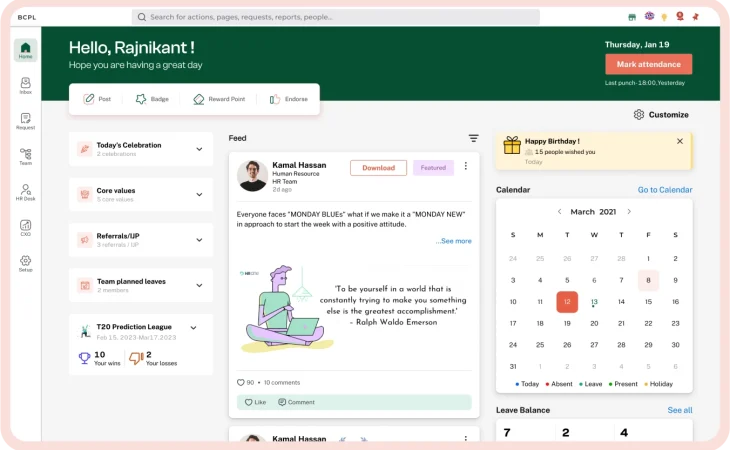
HROne is another excellent HRMS platform which provides various modules to augment the daily activities of the HR department. Being a comprehensive suite, it also has a talent management module that enables the HR team to accurately track employee performance and gather valuable insights using in-depth analytics.
▸Key Features:
User-friendly interface
Comprehensive HRMS
In-depth analytics
▸Pricing:
Basic Plan: ₹85/user/month for 50+ team
Professional Plan: ₹115/user/month for 50+ team
Enterprise Plan: Quote on demand.
8. SAP SuccessFactors

SAP SuccessFactors is another excellent suite of complete HRMS tools that enable HR to undertake their tasks with enhanced efficiency. Its talent management module provides various functionalities such as precise goal-setting, continuous feedback, monitoring employee performance, gathering in-depth insights, and more.
▸Key Features:
Fine-tunable to meet the exact specifications of an organization
A complete HRMS for tacking all tasks
▸Pricing:
Quote on demand
9. Keka
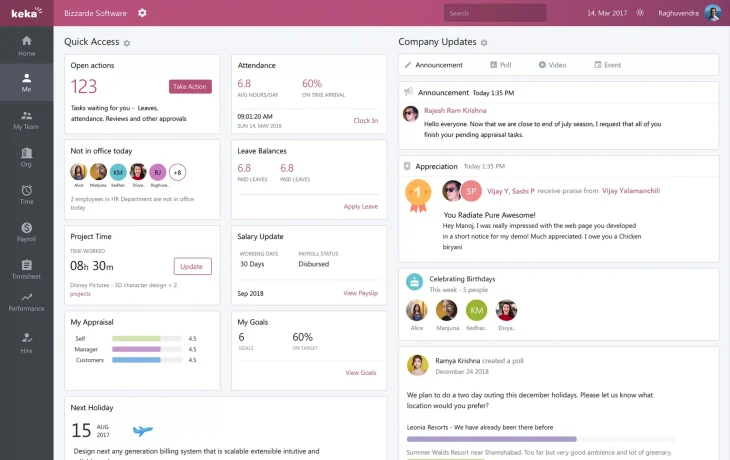
Keka is another popular HRMS in India that provides performance management functionalities. Being a complete HRMS, it is highly customizable and offers several features such as setting employee goals, monitoring their performance, gathering data and generating patterns on their performance figures.
▸Key Features:
Comprehensive HRMS with customizable features
In-depth analytics and reporting module
▸Pricing:
Foundation Plan: ₹6,999/month for up to 100 employees
Strength Plan: ₹9,999/month for up to 100 employees
Growth Plan: ₹13,999/month for up to 100 employees
10. OracleHCM
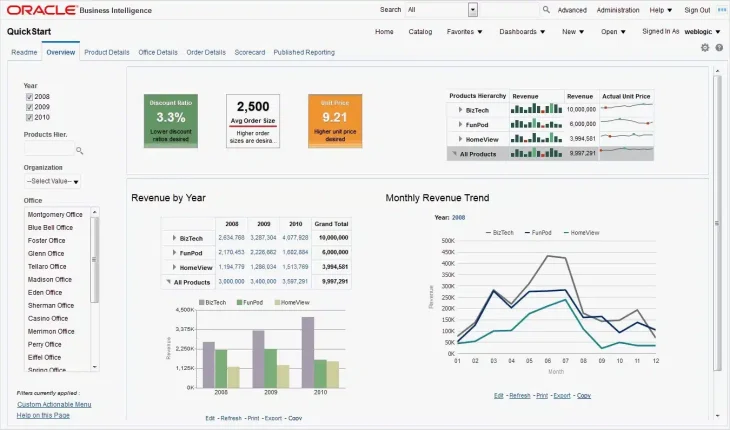
Oracle HCM is a complete HCM solution with a highly flexible architecture, which enables it to be used by companies of all sizes. Being a complete hire-to-retire solution, it also comes with multiple features to manage employee performance such as accurate performance tracking, rewards and recognition, reports generation, and more.
▸Key Features:
Comprehensive HCM suite
Offers all performance management features
▸Pricing:
Quote on demand
11. BambooHR

BambooHR is another popular choice for companies searching for HR management systems. Its talent management module is comprehensive and includes various features such as goal-setting and tracking, review management, feedback mechanisms, and more.
▸Key Features:
Comprehensive performance management system
Complete HR management software
Intuitive user interface
▸Pricing:
Quote on demand
What Is The Best Usage Of Performance Management Software?
One of the key purposes of using performance management software is maintaining track of employee performance, providing deliverable feedback, and processing employee increments accordingly. However, it has other more important motives that improve employee management and productivity. Those are,
Recognizing Employee Performance
Performance management software helps employers track and recognize every employee’s performance consecutively through different processes and enhances individual and team contributions within the workplace.
Through this process, the system ensures fair recognition, making every employee feel valued and appreciated for their contributions.
Besides, performance tracking tools often include analytics to identify trends, areas for improvement, and potential development opportunities through data aggregation, trend analysis, and benchmarking against industry standards.
Continuous Feedback Delivery
A performance management system tracks performance and understands employees’ expertise. Along with tracking, it also provides high-end feedback delivery facilities for ongoing dialogue between employees and managers. Integrating regular feedback into daily work routines helps identify and address issues promptly, fosters continuous development, and aligns individual performance with organizational goals.
Effective Goal Setting and Achievement
A performance management system provides personalized performance matrices for employees and employers. It helps employers set goals and assist employees in achieving them. With the assistance of the system, employers set task targets and track employees’ performance accordingly. Conversely, employees can get a personalized overview of their performance metrics using the ESS portal and provide feedback and managers’ remarks. Besides, the system guides the employees in choosing personalized courses relevant to their career growth.
Consistent Employee Monitoring
Though monitoring employees’ performance manually and arranging spreadsheets can be possible for small companies, it becomes challenging for mid and big companies. The performance management system is a one-stop solution for consistently monitoring employees. It ensures consistent employee monitoring, provides real-time feedback, and delivers accurate performance metrics, thereby saving time and increasing productivity for employers and decision-makers
Employee Reskilling and Upskilling
Performance management provides real-time employee performance matrices and structures feedback and development plans tailored to employees’ needs. The system identifies employee skill gaps and development areas by strategising a clear task goal and analysing employees’ performance parameters and informs employers for processing feedback or real-time reviews.
The system plays a crucial role in facilitating targeted training and learning opportunities. By setting clear goals and tracking progress, it ensures that employees acquire the necessary skills for their current and future roles. It also provides open communication assistance between employees and employers through the help desk and open chat box options.
What Are The Types Of Performance Management Software?
Employers can implement these 5 types of performance management systems in their organizations.
1. The Balanced Scorecard
Balanced Scorecard, a digital scorecard, provides a comprehensive view of overall employee and employer performance, program details, etc. It doesn’t measure individual performance by key performance indicators (KPI). Most organizations rely on this scorecard to measure financial, customer-related decision-making, or internal processes, enabling learning and growth perspectives. The comprehensive approach reassures employers about maintaining the organization’s overall growth & development and instils confidence in the scorecard’s effectiveness.
2. 360-degree feedback system
One of the essential performance management system types is the 360-degree feedback mechanism. This system, also known as multi-rater feedback, provides anonymous feedback from multiple resources such as managers, peers, direct reports, and subordinates instead of focusing on managers’ feedback only.
In this feedback system, employees get the results of some assessments based on the views of other colleagues. It helps employers maintain unbiased employee feedback and aids the employees in understanding their strengths and weaknesses in their career progression.
3. Key Performance Indicator
Key performance indicator (KPI) software, a type of performance management system, tracks the overall organization’s performance using dedicated performance tracking tools. Employers can use the trackers daily, monthly, or yearly, ensuring regular feedback generation. The KPI characteristics empower HR professionals to stay in control and make informed decisions. They can also set employee goals that align with the department’s goals and objectives.
4. Management by Objective (MBOs)
Management by Objective is a performance management approach in which employers and employees set goals aligning with the organization’s objectives. The process involves defining clear targets, regularly monitoring progress, and providing feedback to ensure employee growth and achievement.
During the tenure, employers try to enhance motivation within the workplace, clarify employee expectations, and enrich accountabilities. The main aim of the approach is to improve organizational performance by ensuring that individual efforts contribute directly to broader business goals.
5. Performance Review Software
Performance review software is one key type of performance management. It enables the manager to assess the employee’s performance and provide valuable feedback directly.
The software assists in measuring employee performance using key indicators and standardized metrics, including self-evaluation. However, the software is not the sole factor in a successful performance review process. Effective communication between managers and employees is crucial, especially in feedback provision. Moreover, the software is aligned with the attendance management system to evaluate the performance review on a time basis.
Major Components of a Performance Management System
A performance management system can be divided into a few major components which ensure its effective functioning. Separating the components will help you understand the system’s workings and provide insights into deploying a robust performance management system for your company.
The major components of a performance management system are:
➔ Boosted Performance
The most significant benefit of deploying a performance management system is the boost visible in employee performance over time. Since the staff realize that a dedicated system tracks their daily work, they tend to work better, avoiding lethargy. Such improvement in performance can also be easily tracked using the performance management system.
➔ Enhanced Motivation
Another major benefit is improved employee motivation. Since the staff understand that the performers will be recognized and rewarded in the company, they will be motivated to work better to achieve the organizational goals. Such motivation results in an increase in overall productivity, leading to better overall branding and long-term success.
➔ Improved Retention
With improved productivity and motivation, employees will remain engaged with their organization. Such interactivity will ensure long-term retention, as they feel a personal connection with their company. Improved retention will also enhance productivity, as they understand their organization better.
➔ Time & Cost Savings
Deploying a performance management system will also result in increased time and cost savings. The HR team can easily track the employees’ performance and provide steps to enhance their performance as required. The system can also share in-depth insights with HR and management, making it very easy to reward the performers and upskill the underperformers.
➔ Increased Engagement
The aforementioned factors increase staff engagement in the workplace as they get motivated to work harder for their company. Since they understand that their performance is being monitored continuously, it will result in improved performance, leading to better productivity and appreciation from the management, culminating in increased engagement.
➔ Skill Gaps Identification
A robust performance management system also helps the HR department identify any skill gaps in the workforce. Since their work is continuously being analyzed, the employees’ performance can be measured accurately, resulting in the HR team understanding their shortcomings and skill gaps. With such accurate skill gap identification, the HR team can suggest the perfect training program to their staff, resulting in choosing the right skills for upskilling the team.
➔ Effective Upskilling
With the correct identification of skill gaps, the HR team can set performance management software to assign relevant employee training. Modern performance management systems can even use AI to identify employees’ key traits and assign them the right training for upskilling. Training that enhances their inherent skillset would also interest the employees, making it highly effective for the company.
➔ Reduced Paper Trails
A robust performance management system will reduce the overall paper trail since all metrics will be measured digitally. It will also reduce the time and cost of performance measurement and keeping records of all data generated. As a result, it will become very easy for management and HR to check the database and make data-backed decisions for the employees.
Performance Management System
How Does Performance Management Software Work For The HR Team, Managers, and Employees?
The performance management system has only one motto: streamlining employee management processes by enhancing employee performance output and company productivity. The Performance Management system in India serves differently for HR professionals, managers, and employees.
1. For HR Professionals
Performance management software is a tool for HR professionals that assists them in smoothly managing overall employee work performance. It plays a key role in providing primary feedback, tracking employees’ performance, and rewarding or training employees for career development.
Besides, performance management tools can help HR centralize and store performance data, follow tech trends, maintain compliance updates, manage documentation, and generate reports that improve the overall business.
2. For the Managers
The performance management system provides crucial support to managers in real-time tracking, evaluating employee performance and delivering feedback.
The software sets a clear goal for the managers and provides transparent, on-time employee performance metrics throughout the year; hence, managers can effectively identify high performers and those needing additional support and act accordingly.
Moreover, the system’s alignment with tech trends and cutting-edge compliance ensures it stays ahead of the curve, leading to a better approach and enhancing decision-making during performance appraisals.
3. For Employees
Performance management software is a convenient tool that assists employees in setting and tracking their personal goals and self-performance progress. With this platform, employees can easily grasp their growth statistics and make informed decisions about their career progress.
Moreover, the platform maintains transparency and provides real-time updates on both the employee and employers’ dashboard. Hence, employees are always aligned with organizational goals and don’t need to prove their efforts every time before appraisals. They can take ownership of their performance and growth.
What Are The Common Features of Performance Management Software?
It can be a wonder list describing the most common features of the performance management software that should be in every performance management tool. Those highlighted features are,
Proper Goal Setting
Setting a goal is mandatory for completing any task. An organization has thousands of employees, so setting a goal for each of them is difficult. High-level professionals often face challenges when analyzing whether an employee meets the goal. Hence, the presence of a performance management system with goal-setting functionalities like KPIs or SMART goals makes the employees more productive and more dedicated to their jobs.
Regular 360-degree Feedback
The 360-degree feedback mechanism, a cornerstone of a performance management system, is a testament to the system’s fairness. But what exactly is this mechanism? It’s an approach that ensures employee performance reviews and feedback are conducted through a self-assessment test and others’ reviews. This includes not only managers’ feedback but also that of other employees or colleagues.
With the 360-degree mechanism, employees can get unbiased feedback on their performance, evaluate themselves, and are encouraged to strive for further progress.
Consistent Improvement and Self-evaluation
For employees, having a performance management system is a bright opportunity for self-improvement and self-evaluation. This mechanism allows the employees to attend their self-assessment through the PMS or KPT techniques, where they can rate themselves and wait for the managers’ rating for the final performance report. If they evaluate themselves and find any shortcomings in their performance, they can apply for further training courses. Otherwise, the company will provide some rewards as well.
Rewards and Recognition
One of the key features of the performance management system is identifying the employee’s performance and delivering proper feedback. It is further advanced to rewards and recognition. The system ensures employee appraisals occur at specific intervals, such as half-yearly, yearly, or monthly. Besides, the tracking tool helps the employee do self-performance evaluations along with the employers and helps employers choose the right candidate for rewards.
Measuring and Tracking
Any performance management system measures and tracks employee daily performance. It introduces different features and functionalities like, OKRs, Balanced Scorecards, Performance Appraisal Forms, 360-degree feedback, and many more. Using those platforms, employees can evaluate their performance independently. Conversely, employers can efficiently access real-time employee performance metrics before appraisals, enhancing their effectiveness.
Training and Personal Development
Training and development functionalities are one key feature of the performance management system. The tool makes employees feel valued and satisfied about their future career plans. People may wonder how training and development work in performance management systems. The performance management system is designed to align with the training management system, offering employees a wide range of training courses when needed. Employees can take multiple courses using performance software and associated training management tools without seeking HR permission.
Multi-level Integration Facilities
In an HRMS software solution, the employee management system is complemented by various supportive systems and tools, with the performance management system being a key component. The performance management software’s multi-level integration facilities provide a user-friendly interface and a comprehensive one-stop solution platform convenient for employers and employees. Besides, add-on automotive functionalities make the integrated system more flexible and supportive.
What Are The Benefits of Performance Management Software?
In an organization, management always wants to lead the business more agilely and prepare the company to adapt to new challenges and opportunities. Aligning with the performance management system can be one of the nicest options for reforming and updating the workplace with the world’s tech trends. Here are the trending benefit options of performance management systems.
1. Boost Motivation
A performance management system empowers employees by providing a platform to track their performance using ESS, rate their work on performance metrics, and receive real-time feedback. Moreover, the system ensures that the employees receive an unbiased performance rating, putting them in control of their career growth. Overall, it builds up employee motivation for work.
Employers can be assured of an efficient process with the performance tracking platform. They no longer need to track performance manually and can confidently access on-time, ready-made employee performance metrics before appraisals. Besides, employers evaluate employee attendance by integrating the GPS attendance system with the performance tracker.
2. Enhanced Employee Retention
A workplace where the most motivated employees stay with the company for a long time. Performance management software and associated strategies assist employers in keeping employees for an extended period. Integrating a performance management system is a crucial technique for maintaining employee retention.
Using the platform, employees can track their performance and receive real-time feedback. The system plays a crucial role in recognizing and rewarding their hard work, making them feel appreciated and motivated. With the help of ESS, they can participate in the assessment process and receive the right increment, all without the need to showcase their performance manually. Thus, all this results in employee retention for a longer period.
3. Employee Engagement
The performance management system achieves transparency between employees and employers through efficient performance tracking. Employees can use the ESS portal to track their performance at specific intervals. They can also deliver self-feedback and tally it with their manager’s remarks, enhancing their recognition. This entire process improves employee engagement and leads to long-term employee retention.
4. Affluent Training Opportunities
Every employee values a workplace that invests in their growth and updates them with the latest tech trends. By aligning performance management with the training system, companies provide ample opportunities for self-development, which is crucial for employee engagement and retention. When employees can enhance their skills without financial burden, they are more likely to stay with the company, contributing to a skilled and committed team.
5. Effective Talent Nurturing
Management has to manage thousands of employees in a broad range of big companies. Often, it becomes risky for employers to choose the best employees and reward them. Performance management systems deliver detailed techniques like PMS fulfilment and time tracking, 360-degree feedback facilities, and transparency while selecting genuine reward-worthy employees.
6. Identifying Potential Risk
Similarly, identifying candidates for promotion and recognizing poor performers can be daunting for employers. A performance management system here empowers employers with effective performance trackers and feedback mechanisms. These tools provide transparent performance metrics, enabling employers to confidently decide about appraisals and skill development courses for improved future output.
Performance Management Software Market Trends
Since we are discussing performance management software, we should understand the current trends in the software market. A thorough understanding of these trends will help us understand the latest features we need to be aware of when searching for the ideal performance management system.
Hence, we have enumerated the common and best performance management tool trends below:
➔ Cloud Architecture
Since the world is moving towards a digital 24/7 connected ecosystem, performance management software has also adopted the cloud architecture to stay relevant. Cloud computing has multiple benefits over the traditional client-server architecture, such as round-the-clock remote availability, hardware independent access, improved accessibility, enhanced backup options, increased security, and more. Hence, all major performance management systems have adopted the cloud computing architecture to provide a seamless service experience for their clientele.
➔ Strategic Data-driven HR
With the integration of HRMS with performance management software, human resources have evolved into ‘strategic HR’, which uses employee and company data to help the HR teams undertake their routine tasks. Data-backed strategic HR tactics are more effective than traditional HR strategies since they consider the consequences of the decisions on the employees and the employer. Hence, modern performance management systems provide in-depth analytical tools to help HR gather valuable insights into employees’ performance.
➔ Integrated Solutions
With the added usability and accessibility of performance management systems using cloud architecture, it has become much easier for the HR team to assess their employees effectively. However, their performance data must be fed into analytical systems like an HRMS to gather valuable insights. Similarly, the performance data provides HR with accurate appraisal numbers, ensuring fair salary increments. Hence, the performance management system must be integrated with other commonly used software.
➔ Human Experience
The human experience refers to giving meaning to the staff’s work. It can be accomplished by personalizing their work and helping them understand the value of their work for the organization. This results in increased productivity and contributions, leading to satisfied employees. This trend is vital for a company’s success since productivity directly affects the products and services provided by the organization.
➔ Employee Wellness
The aftermath of the recent global epidemic has resulted in increased awareness and emphasis on employees’ mental and physical well-being. Hence, many companies provide numerous benefits for their employees while including them in their performance management practices. This helps the staff realize their importance in the company, leading to long-term retention.
FAQs
Integrating the right performance management software is one of many ways to maintain employee workplace performance. Here is a quick overview of how you maintain good practice in managing employee performance daily in the organization.
Define SMART objectives and set clear & achievable targets that align with the company goal.
Check employee performance and provide the right feedback frequently.
Plan for a consistent and transparent appraisal process.
Commence recognizing achievements by acknowledging and rewarding employees.
Provide relevant training opportunities to every employee while required.
Encourage employees to initiate open communication and deliver honest dialogue about performance.
Build a supportive environment where every employee feels valued and appreciated.
Yes, your company may need performance management software to develop employees’ leadership skills by providing guidance on upcoming tasks and responsibilities, receiving feedback, and providing high-end support for their future goal achievement and business objectives.
The cost of implementing the best performance management depends on the software companies you choose and the features and functionalities you require to analyze variances against the standards.
Continuous performance management is an ongoing approach to managing employee performance on a routine basis. It mainly focuses on regular checking, analysing performance, generating feedback, and real-time development rather than depending on the traditional year-end performance analysing and feedback process.
Here, the most common problems employees and employers face after integrating with the performance management system are:
Absence of proper goal and achievement
Inadequate feedback and miss-communication
Absence of adequate Training and development
Limited resources and miss-management of time
Lack of Employee engagement and retention
Added cost of integration and maintenance.
The performance management system is flexible enough to integrate with the other HRMS tools. Besides, the software can smoothly align with the software with its distinct performance management processes, organizational culture, and strategic objectives, ensuring that it effectively supports their specific needs and enhances overall performance management.
Performance management software comes with robust security features that protect sensitive employee data, including encryption, access controls, and compliance with data protection regulations such as GDPR or CCPA.
However, different performance management software has different levels of security features, depending on the software provider and the organization’s implementation practices.

